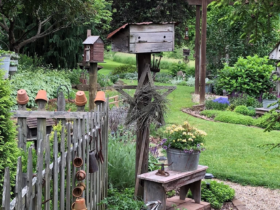The vast majority of townsfolk prefers to buy young grape bushes, although this method of landscaping the site has a number of significant minuses, namely, high costs and risk that the seedling will not take root in the place of landing. True, there is another option — independent cultivation, which, with a competent approach, does not require excessive financial and time costs. To make sure that even this article will help even an unprofessional gardener to deal with cuttings and landing of wine berry.
A phased description of the process of growing seedlings until the moment of landing
The propagation of such a garden culture as grapes begins with cuttings, that is, trimming part of fruiting bushes in order to further grow as a separate plant. The optimal time for this process is autumn, in particular, the time of falling leaves, since it is during this period that the wood contains the greatest amount of useful substances, which makes autumn blanks better adapted to rooting than spring.
Having decided on a suitable vine, the thickness of which should be, like a pencil, it is necessary to cut off several cuttings with 3-4 buds and a length of thirty to forty centimeters. It is important that after the cut is performed at a distance of 4-5 cm from the kidneys, the future seedling is, thoroughly wrapped in moss, or wet fabric. You can store cuttings either in the refrigerator (on the lower shelf), having previously wrapped in polyethylene to avoid overdrying, or in the cellar, where the cool medium and a high level of humidity are also supported.
In the 2-3rd week of March, the blanks need to be removed and a cut at an angle of 90 degrees under the kidney below, after which at a distance of about two or three centimeters from the kidney, perform a slanting trim on top so that the juice along the vine is descended from the other side of it. After removing the extreme kidney, 1/3 of the below will be with the help of a sharp object (knives, razors, etc. D.) cut it longitudinally in order to improve and accelerate the process of germination of roots. Then, for 2 days, the cuttings should be kept completely immersed in water, the temperature of which does not exceed 18 degrees, while to intensify root formation, you can add 1 t. a spoonful of honey or special drugs such as biostim, Kornevin, Human, heteroauxin and Epin.
To germinate the kidneys, the cuttings should be placed in a sunny place (the windowsill should go out to the southern or south-west side) in a bank with a capacity of 1 liter filled with 3-4 cm water. The main thing is to track so that there is always enough water in the bank and, if necessary, add it. Following these simple rules, you can see that first (about 14 days later) they will be opened almost, and after a week the roots will begin to grow.
By the time of landing, novice gardeners should take care of the preparation of suitable containers, in particular, it is easiest to use tetrapaks in which milk is sold. Previously, their top is cut off, and holes are made in the bottom, after which the container is placed on the pallet of the suitable size and you can start filling it with a landing substrate. First of all, expanded clay is poured to ensure good drainage, and then the Earth, which is a mixture of equal in volume of the amount of fresh leaf humus from the forest, sand and garden soil (all ingredients are thoroughly mixed).
The next to a height of 5-6 centimeters is poured out soil, where you need to gently place the stalk, while the visible part of the plant should be at least 15-20 cm. The seedling should be sprinkled with earth on each side, avoiding soil compaction to preserve the optimal soil structure — in addition, the stalk will shrink eventually with time. During the development of the root system of grapes, it should be taken to ensure that the Earth is not dry or vice versa excessively humid, as this slows down growth. Ideally, watering should be carried out often, but in a small amount. As for top dressing, at this stage there is no particular need for it.
The shooting of shoots is carried out every 2-3 weeks from the moment the active appearance from the foliage from the kidneys. Ultimately, by the first day of May, your disposal will be a well -formed bush of wine berry, ready for landing.
Alternative grape cultivation options
Along with the above method, there are alternative methods that it makes sense to consider in more detail:
Growing with the help of root layering is the easiest option, which involves digging the root of a ripened plant, its plug and subsequent digging into the longitudinal fossa of a small depth. The root should be laid in the horizontal direction, then thoroughly fill it with fresh humus and water it as often as possible. Thanks to intensive watering and the receipt of beneficial trace elements, many kidneys are formed, and the first sprouts are visible on the surface already after 1-2 weeks. As soon as they get stronger, you can dig a rhizome and pruning and further landing in the selected place.
Summer digging of shoots — the optimal solution in cases where there is a formed bush of grapes and a fairly large plot of land. This method cannot be called the fastest, but it requires a minimum of effort from the novice gardener. First of all, we select a healthy and strong branch, determining the part from which dug will be made down. On the chosen side of the vine, we make furrows (the easiest way-with the help of a razor, although a sharp knife is also suitable) to stimulate the formation of the root system, after which we instilate a branch of 15-20 centimeters parallel to the level of earth. Do not forget to leave the end of the branch outside. As a result, after a short period of time, many kidneys will germinate and, if you do not forget about periodic pinching, then you will grow a bush with branched roots. When the shoots are formed, it is necessary to dig out and cut the branch into parts in accordance with the number of future seedlings. The disadvantages of this method include a delay in fruiting, due to damage to the rhizomes of young bushes. Until the first harvest is received in the case of proper and regular care, at least three years pass.
Air Division is a fairly common way used in late spring and in the first weeks of summer. At the first stage, the entire foliage and the upper layer of the bark are removed from the lower part, selected for the reproduction of the vine, while the bark ring should have a perpendicular direction in relation to the direction of the grape branch. Cuts are made from above and below the cut off, after which a plastic bag is put on a branch, not forgetting about a tight winding below the place where the furrows are made. Inside, a wet mixture is placed from humus, sand and earth, after which the bag is thoroughly closed on top. In order to avoid overheating, it is advisable to wrap an isolated vine with additionally thick paper, minimizing the risk of penetration inside the sunlight, while it is important that the packet with the soil is always vertically located. By the fall, the roots are formed, which indicates that seedlings can be planted by previously cutting a branch with 3-4 buds.
Competent landing is the key to the successful development of fruiting bushes
It is difficult to overestimate the importance of proper landing, because it is on it that the intensity and speed of the transformation of seedlings into full fruiting bushes depends on it. The key value is:
Providing deep watering
Creation of deep pits with drainage.
The depth of pits for chuboks, which are made in the form of squares 60 centimeters wide, should be in the range from 80 to 100 cm. Several layers are consistently laid at the bottom: ash (about 400 grams), drainage (broken brick, crushed stone, expanded clay) with a height of 10 cm or more, a slate sheet and a vertically located part of the pipe from 1 meter long. From the point of view of practicality for delivering water and fertilizers to the rhizome to the rhizome, it makes sense to use pipes from asbestos, since they have resistance to corrosive effects. Having installed the pipe on the north side, we fill the pit with a pre-mixed mixture of soil (what we removed from the pit) and 2 buckets of humus-if we are talking about heavy soil, then 0.5 buckets of sand can be added to outline the structure. The soil is poured into twenty to thirty centimeters deep into the center, while an earthen slide is additionally made in the center, where we place a chubuk (another name of the grape seedling), and then melt the roots and carefully fill the earth. It is imperative to ensure that the 2nd lower buds are covered with soil, and only the shoots of the upper part come out. Subsequently, the Earth will shrink and it will be necessary to adjust the position of the pipes. The latter fall asleep mulch so that the branches remain in the field of visibility.
Within 1 year, a weekly water is poured into the pipe, depending on the temperature indicators, and the upper part must be closed with a can of canned food to avoid clogs and the penetration of bacteria. During autumn landing, the seedling should be additionally covered for the winter, and in the spring begin to active watering, so that by the last weeks of summer, get a ripened bush with good roots, which can be fruitful after 12 months after 12 months.
There are situations, in particular, when, a large number of recently planted plants, when it is more advisable to make trenches, having bushes in two rows at a distance of 2 meters. At the same distance from the rows of the rod, a meter trench, filling it in the same way as the hole, and fixing the pipes in the central part, with a two -meter gap from each other. In the direction of the trench, we make several oblique pits where we put the chuboks, while the slope of the plants, including straightened roots, should be directed into the strip of the main deepening. This will allow roots to quickly gain access to nutrients and moisture, so literally a year later all seedlings will turn into powerful vine vines.
Necessary tools and materials for growing and planting grape seedlings
The list of what you need to grow seedlings includes:
A device for barking bark — razor or a sharp knife;
bank of 1 liter;
cardboard tetrapaks or other containers suitable for growing cuttings;
fabric for wrapping cuttings in the winter;
multifunctional packets made of polyethylene;
drainage materials, in particular, broken brick, expanded clay, crushed stone;
ash;
sand and fresh forest humus from leaves;
wrapping paper with increased density;
nylon threads;
shovel;
small pieces of pipes (about 1 m long) and slate;
a secateur for neat pruning;
trellis (necessary for garter when using the method of air discharge).













Оставить коммент.